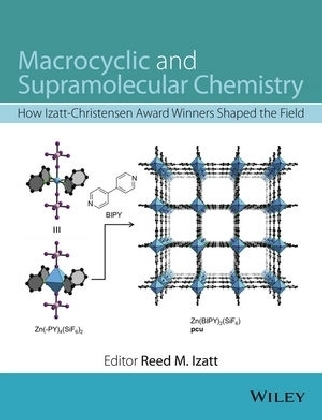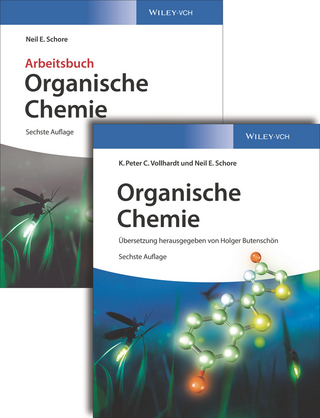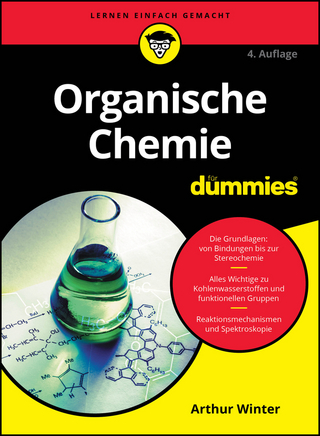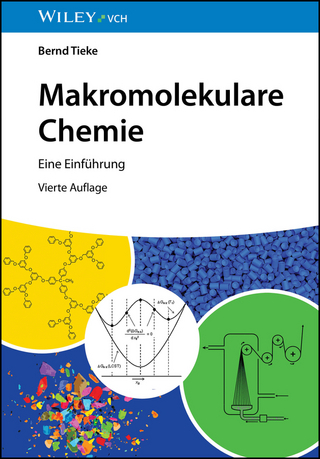
Macrocyclic and Supramolecular Chemistry
John Wiley & Sons Inc (Verlag)
978-1-119-05384-2 (ISBN)
- Titel z.Zt. nicht lieferbar
- Versandkostenfrei innerhalb Deutschlands
- Auch auf Rechnung
- Verfügbarkeit in der Filiale vor Ort prüfen
- Artikel merken
Macrocyclic and Supramolecular Chemistry: How Izatt-Christensen Award Winners Shaped the Field features chapters written by the award recipients who provide unique perspectives on the spectacular growth in these expanding and vibrant fields of chemistry over the past half century, and on the role of these awardees in shaping this growth. During this time there has been an upsurge of interest in the design, synthesis and characterization of increasingly more complex macrocyclic ligands and in the application of this knowledge to understanding molecular recognition processes in host-guest chemistry in ways that were scarcely envisioned decades earlier.
In October 2016, Professor Jean-Pierre Sauvage and Sir J. Fraser Stoddart (author for chapter 22 "Contractile and Extensile Molecular Systems: Towards Molecular Muscles" by Jean -Pierre Sauvage, Vincent Duplan, and Frédéric Niess and 20 "Serendipity" by Paul R. McGonigal and J. Fraser Stoddart respectively) were awarded the Nobel Prize in Chemistry alongside fellow Wiley author Bernard Feringa, for the design and synthesis of molecular machines.
Dr. Reed M. Izatt, Charles E. Maw Professor of Chemistry (Emeritus), Brigham Young University, U.S.A. Reed M. Izatt received a BS degree in Chemistry from Utah State University (1951) and a PhD degree in Chemistry from Pennsylvania State University (1954). After post-doctoral work at Mellon Institute of Industrial Research, he embarked on an academic career at Brigham Young University retiring as Charles E. Maw Professor of Chemistry (1993). He is the author or co-author of over 550 publications. Reed has edited several books, contributed numerous chapters in books, written many journal and review articles and presented plenary, invited, and regular lectures at universities worldwide; regional, national, and international chemistry conferences; and government laboratories. Reed has been involved in research in macrocyclic chemistry since the late 1960s. Together with James Christensen, he organized the first Symposium on Macrocyclic Chemistry in Provo, Utah in 1977. This Symposium has thrived and was one of the major precursors of the present ISMSC.
List of Contributors xv
Preface xviii
Acknowledgements xx
1 The Izatt–Christensen Award in Macrocyclic and Supramolecular Chemistry: A 25-Year History (1991–2016) 1
Reed M. Izatt, Jerald S. Bradshaw, Steven R. Izatt, and Roger G. Harrison
1.1 Introduction 1
1.2 International Izatt–Christensen Award in Macrocyclic and Supramolecular Chemistry 2
1.3 International Symposium on Macrocyclic and Supramolecular Chemistry 4
1.4 Izatt–Christensen award sponsor: IBC Advanced Technologies, Inc. 6
1.5 Summary 7
References 8
2 Supramolecular Chemistry with DNA 10
Pongphak Chidchob and Hanadi Sleiman
2.1 Introduction 10
2.2 Motifs in structural DNA nanotechnology 10
2.3 Dynamic assembly and molecular recognition with DNA 13
2.4 Supramolecular assembly with hybrid DNA materials: increasing the letters of the alphabet 14
2.5 Conclusion 33
References 34
3 Anion, Cation and Ion-Pair Recognition by Macrocyclic and Interlocked Host Systems 38
Paul D. Beer and Matthew J. Langton
3.1 Introduction 38
3.2 Electrochemical molecular recognition 38
3.3 Anion recognition and sensing by macrocyclic and interlocked hosts 44
3.4 Halogen-bonding anion recognition 55
3.5 Ion-pair recognition 59
3.6 Metal-directed self-assembly 62
3.7 Conclusions 67
3.8 Acknowledgements 67
References 67
4 Perspectives in Molecular Tectonics 73
Mir Wais Hosseini
4.1 Preamble: dreams and pathway 73
4.2 Introduction 75
4.3 From tectons to networks 75
4.4 Summary and outlook 87
4.5 Acknowledgements 88
References 88
5 Three Tales of Supramolecular Analytical Chemistry 92
Margaret K. Meadows and Eric V. Anslyn
5.1 Introduction 92
5.2 Citrate sensing 93
5.3 Rapid analysis of enantiomeric excess 101
5.4 Differential sensing 109
5.5 Conclusion 123
References 123
6 Robust Host–Guest Chemistry of Cucurbit[n-uril: Fundamentals and Applications of the Synthetic Receptor Family 127
Kimoon Kim, Dinesh Shetty, and Kyeng Min Park
6.1 Personal pathway to the discovery of cucurbit[n-uril and early day developments 127
6.2 Structures and physical properties of CB[n- 129
6.3 General host–guest chemistry of CB[n- 129
6.4 High-affinity host–guest pairs 130
6.5 Functionalized CBs 133
6.6 Applications of high-affinity CB[6- complexes 134
6.7 Applications of high-affinity CB[7- complexes 137
6.8 Conclusions 140
6.9 Acknowledgements 141
References 141
7 Molecular Recognition in Biomimetic Receptors 146
Peter C. Knipe, Sam Thompson, and Andrew D. Hamilton
7.1 Molecular recognition in biological systems 146
7.2 Model systems to investigate fundamental forces 146
7.3 Recognition of more complex systems – into the realm of peptides 149
7.4 A general approach to peptide mimicry – targeting secondary structure 152
7.5 Super-secondary structures and beyond 156
7.6 Outlook 159
References 160
8 A Lifetime Walk in the Realm of Cyclam 165
Luigi Fabbrizzi
8.1 Synthesis and development of cyclam and related macrocycles 165
8.2 Macrocyclic effects and the importance of being 14-membered 170
8.3 Cyclam promotes the redox activity of the encircled metal ion 176
8.4 Scorpionands: cyclam derivatives with an aggressive tail, biting a chelated metal from the top 180
8.5 Azacyclams: cyclam-like macrocycles with built-in functionalization 187
8.6 Conclusion 193
8.7 Acknowledgements 195
References 196
9 Porosity in Metal–Organic Compounds 200
Alexander Schoedel and Omar M. Yaghi
9.1 Introduction 200
9.2 Werner complexes 201
9.3 Hofmann clathrates 201
9.4 Coordination polymers 204
9.5 Porosity in metal–organic frameworks 209
9.6 The discovery of MOF-5: the golden age of metal–organic frameworks 211
9.7 The Cambridge Structural Database – an essential tool for MOF chemists 214
9.8 Concluding remarks 215
9.9 Acknowledgement 215
References 215
10 Cyclodextrin-based Supramolecular Systems 220
Akira Harada
10.1 Introduction 220
10.2 Cyclodextrin-containing polymers 220
10.3 CD-organometallic complexes 222
10.4 Complex formation of cyclodextrin with polymers 223
10.5 Polymerization by CDs 225
10.6 Supramolecular polymers 228
10.7 Side-chain recognition by CDs 230
10.8 CD-based molecular machines 230
10.9 Macroscopic self-assembly through molecular recognition 233
10.10 Self-healing by molecular recognition 235
10.11 Stimuli-responsive polymers 236
10.12 Conclusion 238
References 238
11 Making the Tiniest Machines 241
David A. Leigh
11.1 Introduction 241
11.2 Property effects using molecular shuttles 245
11.3 Molecular motors and ratchet mechanisms 248
11.4 Small molecules that can “walk” along molecular tracks 254
11.5 Making molecules that make molecules 257
11.6 Outlook 257
11.7 Acknowledgements 259
References 259
12 Clipping an Angel’s Wings 261
Roeland J.M. Nolte, Alan E. Rowan, and Johannes A.A.W. Elemans
12.1 Introduction 261
12.2 Molecular clips 263
12.3 Molecular capsules 278
12.4 Outlook 282
12.5 Acknowledgements 282
References 283
13 From Lanthanide Shift Reagents to Molecular Knots: The Importance of Molecular and Mental Flexibility 288
Jeremy K.M. Sanders
13.1 Introduction: 1969–76 288
13.2 Metalloporphyrins 289
13.3 Macrocycles based on cholic acid 296
13.4 Designed donor–acceptor catenanes 297
13.5 Dynamic combinatorial chemistry 298
13.6 Conclusions 304
References 305
14 Texaphyrins: Life, Death, and Attempts at Resurrection 309
Jonathan L. Sessler
14.1 Introduction 309
14.2 Early days 309
14.3 Starting Pharmacyclics, Inc. 311
14.4 Early biological studies of texaphyrins 314
14.5 Clinical studies of texaphyrins at Pharmacyclics, Inc. 316
14.6 Changes in direction at Pharmacyclics, Inc. 316
14.7 Current research efforts involving texaphyrin 317
14.8 Texaphyrin-platinum conjugates 318
14.9 Acknowledgements 321
References 321
15 Macrocyclic Coordination Chemistry of Resorcin[4-arenes and Pyrogallol[4-arenes 325
Harshita Kumari, Carol A. Deakyne, and Jerry L. Atwood
15.1 Introduction 325
15.2 History of hydrogen-bonded pyrogallol[4-arene- and resorcin[4-arene-based nanocapsules 326
15.3 Metal-seamed pyrogallol[4-arene- and resorcin[4-arene-based complexes 327
15.4 Concluding remarks 342
References 342
16 Dynamic Control of Recognition Processes in Host–Guest Systems and Polymer–Polymer Interactions 346
Seiji Shinkai
16.1 Introduction 346
16.2 Dynamic control of crown ether functions by chemical and physical signals 347
16.3 Stereochemical studies of calix[n-arene derivatives 351
16.4 Ion and molecule recognition by functionalized calix[n-arenes and their application to super Na+-sensors and novel [60-fullerene isolation methods 351
16.5 Molecular design of novel sugar-sensing systems using boronic acid–diol macrocyclization 352
16.6 From molecular machines to allosteric effects 353
16.7 From allosteric effects to aggregation-induced emission (AIE) 354
16.8 Extension of cooperative actions to polymeric and biological systems 356
16.9 Summary 357
16.10 Acknowledgements 357
References 357
17 Cation Binders, Amphiphiles, and Membrane Active Transporters 360
George W. Gokel, Saeedeh Negin, Joseph W. Meisel, Mohit B. Patel, Michael R. Gokel, and Ryan Cantwell
17.1 Introduction 360
17.2 Conceptual development of lariat ethers for transport 361
17.3 Recognition of the ability of lariat ethers to form membranes 363
17.4 Use of lariat ethers to demonstrate cation–π interactions 365
17.5 Development of synthetic cation channels based on crown ethers 367
17.6 Development of synthetic anion channels based on amphiphilic peptides 370
17.7 Membrane active amphiphiles as biologically active and applicable compounds 371
17.8 Conclusion 373
References 373
18 Supramolecular Technology 377
David N. Reinhoudt
18.1 Introduction 377
18.2 Chemical sensing 378
18.3 Membrane transport 379
18.4 Nonlinear optical materials 380
18.5 Supramolecular technology for nanofabrication 380
References 382
19 Synthesis of Macrocyclic Complexes Using Metal Ion Templates 383
Daryle H. Busch
19.1 Introduction 383
19.2 Macrocycle synthesis 384
References 386
20 Serendipity 388
Paul R. McGonigal and J. Fraser Stoddart
20.1 Serendipity in scientific discovery 388
20.2 Donor–acceptor charge transfer interactions 390
20.3 Cyclodextrins (CDs) 400
20.4 Conclusions and outlook 410
References 411
21 Evolution of ZnII–Macrocyclic Polyamines to Biological Probes and Supramolecular Assembly 415
Eiichi Kimura, Tohru Koike, and Shin Aoki
21.1 Introduction 415
21.2 Zinc enzyme models from ZnII macrocyclic polyamine complexes 415
21.3 ZnII–cyclens for selective recognition of nucleobases (thymine and uracil) and manipulation of genes 427
21.4 New supramolecular assemblies with ZnII–cyclen 434
21.5 Acknowledgements 438
References 438
22 Contractile and Extensile Molecular Systems: Towards Molecular Muscles 444
Jean-Pierre Sauvage, Vincent Duplan, and Frédéric Niess
22.1 Preamble: the Izatt–Christensen award and Jean-Pierre Sauvage 444
22.2 Introduction 446
22.3 Interlocking ring compounds 447
22.4 Non-interlocking compounds 456
22.5 Conclusion 458
22.6 Acknowledgements 461
References 461
Index 465
| Erscheinungsdatum | 03.08.2016 |
|---|---|
| Verlagsort | New York |
| Sprache | englisch |
| Maße | 196 x 254 mm |
| Gewicht | 1243 g |
| Themenwelt | Naturwissenschaften ► Chemie ► Organische Chemie |
| ISBN-10 | 1-119-05384-6 / 1119053846 |
| ISBN-13 | 978-1-119-05384-2 / 9781119053842 |
| Zustand | Neuware |
| Haben Sie eine Frage zum Produkt? |
aus dem Bereich


